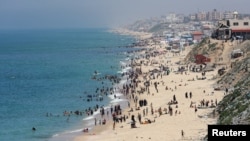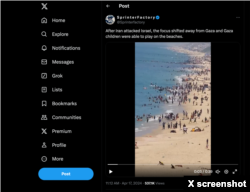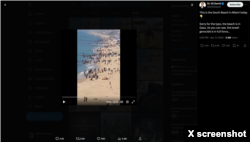The escalation between Israel and Iran saw an exchange of missile attacks, including the April 14 Iranian attack on Israel, followed by the Israeli strike inside Iran on April 18.
Both countries downplayed the scope and impact of the other side’s attacks.
Israel said its air defenses intercepted almost all of Iranian missiles and drones with the help of the U.S. and allies.
Iran claimed its attack on Israel was devastating and sidestepped blaming Israel for the Friday strike.
Throughout its decades-long proxy war with Israel, Iran has been providing financial and military aid to Hamas, whose fighters killed 1,200 people and took 253 hostages, including American citizens, in Israel last October, sparking the ongoing war.
The United States redesignated Hamas as a foreign terrorist organization after that attack. Hamas released some 100 hostages in November but refuses to free the rest, whose fate and well-being remain unknown to their families.
The Israel-Hamas war has been unfolding on the background of massive social media disinformation and misinformation.
On April 17, users on social media X, formally Twitter, widely circulated a video clip of people congregating on a beach in central Gaza.
Pro-Israel, pro-Iran and pro-Hamas X users shared the footage adding misleading and false descriptions that distorted the perceptions about the conflict.
Sprinter Factory, an X content creator with more than half a million followers, used the Gaza beach video to back Tehran’s dubious claim about the success of its strike on Israel.
The post had received more than half a million reactions at the time of this writing. More than 10 accounts also posted variations and exact copies of Sprinter’s post on X, only some of which attributed the original post to Sprinter.
"After Iran attacked Israel, the focus shifted away from Gaza and Gaza children were able to play on the beaches" Sprinter’s post said.
That claim is false.
There is no correlation between the Iranian assault on Israel and the ability of people in Gaza to congregate on that beach, where hundreds of Palestinians had been gathering months before Iran’s strike.
In February, crowds gathered along the same beach to receive food aid that was airdropped by France and Jordan.
The Times of Israel reported that the video was filmed at a beach near Deir al-Balah in central Gaza on April 17.
The beach is close to an east-west corridor that is occupied by Israel Defense Forces (IDF).
YNET, an Israeli news website, notes that while Israeli forces have launched airstrikes throughout the Deir Al-Balah governorate (governorates are administrative divisions in the Palestinian territories), IDF ground forces have yet to enter the city of Deir al-Balah.
Days before the Iranian attack, IDF sources told the Israeli news outlet Walla! that manpower shortages and legal obstacles were hampering Israel’s efforts to secure that corridor, which is intended to serve as a buffer zone between north and south Gaza, the Israeli broadcaster i24NEWS reported.
The Times of Israel noted that no Israeli troops are visible in the beach footage, adding "the free movement of Gazans shows the extent to which troops have pulled back."
But that troop pullback is not linked to what has thus far been a one-off attack from Iranian soil against Israel.
Roughly 70% of Gaza’s population is currently displaced. While a large number have relocated to the southern city of Rafah, some refugees from northern Gaza fled to Deir al-Balah after Israel launched its ground invasion of the territory in October 2023.
Agence France-Presse (AFP) reports that many of the individuals in the beach footage are living in makeshift shelters nearby. One internally displaced person from Gaza’s north told AFP that people had gone to the seashore to escape the sweltering conditions inside their tents.
Pro-Israel X users conversely used the same Gaza beach video to cast doubt on suffering that Palestinian civilians have endured during the war, including the dangers of a man-made famine.
Several X users sarcastically compared the beach scene to South Beach in Miami, Florida, or claimed the people in the footage "were on vacation" and not actually facing a humanitarian crisis.
While the Hamas-run Gaza health ministry remains the sole source of war toll statistics, the United Nations observers and reliable news outlets report the devastating effects of war on the civilian population.
Unverified data by the Gaza health ministry puts the death toll at nearly 34,000 Palestinians killed since October. The ministry does not distinguish between civilians and combatants but says approximately two-thirds of the dead are women and children. Nearly 77,000 people have been injured.
Figures published by The Associated Press earlier this month indicate 55.9% of buildings have likely been damaged or destroyed in Gaza, along with 60% of homes. Approximately 90% of school buildings have been damaged and only 10 of 36 hospitals are functioning. Approximately 1.1 million people are facing "catastrophic" food insecurity, and 31% of children under the age of 2 are acutely malnourished
Israel’s reported April 18 attack over the Iranian city of Isfahan came in response to Iran’s drone and missile attacks on Israel on April 14. The April 14 attack from Iranian soil, in turn, followed the April 1 Israeli strike that targeted the military annex of Iran’s embassy in Damascus, Syria, and killed senior Iranian commanders.
Analysts say Israel’s limited April 18 strikes were calibrated to halt further escalation.
U.S. Secretary of State Antony Blinken said the United States was not involved in Israel’s strike on Iran.
After the April 14 attack, Iranian state-run news outlets portrayed the strikes as more devastating than they were.
Israel says that with the help of the United States and other allies they intercepted 99% of the 170 drones, 30 cruise missiles and 120 ballistic missiles launched by Iran.








